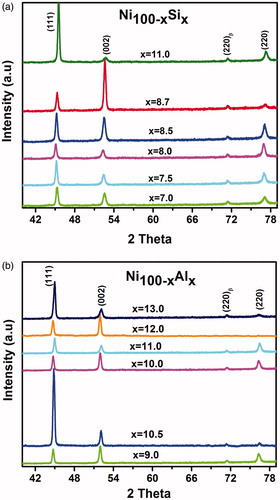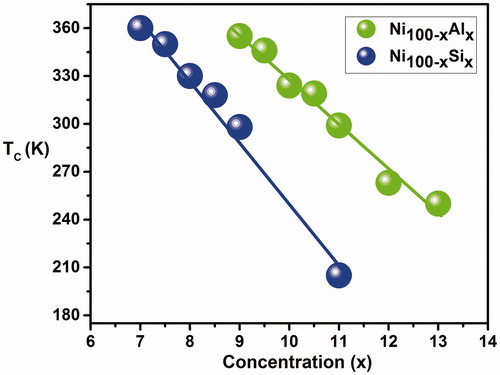Abstract
Self-controlled hyperthermia is a non-invasive technique used to kill or destroy cancer cells while preserving normal surrounding tissues. We have explored bulk magnetic Ni-Si and Ni-Al alloys as a potential thermoseeds. The structural, magnetic and magnetocaloric properties of the samples were investigated, including saturation magnetisation, Curie temperature (TC), and magnetic and thermal hysteresis, using room temperature X-ray diffraction and magnetometry. The annealing time, temperature and the effects of homogenising the thermoseeds were studied to determine the functional hyperthermia applications. The bulk Ni-Si and Ni-Al binary alloys have Curie temperatures in the desired range, 316 K–319 K (43 °C–46 °C), which is suitable for magnetic hyperthermia applications. We have found that TC strictly follows a linear trend with doping concentration over a wide range of temperature. The magnetic ordering temperature and the magnetic properties can be controlled through substitution in these binary alloys.
Introduction
Hyperthermia or thermal therapy is a type of cancer treatment in which body tissue is heated above the normal body temperature [Citation1,Citation2]. Research has shown that temperatures in the 315–319 K (43–46 °C) range can destroy or kill cancer cells [Citation3–7]. Hyperthermia has also been used in conjunction with other forms of cancer therapy, such as radiation therapy and chemotherapy [Citation7,Citation8]. It has been shown that hyperthermia conditions make cancer cells more susceptible to radiation and certain anticancer drugs, and it can be used to attack cancer cells that are not affected by radiation.
Magnetic hyperthermia is a method of hyperthermia treatment in which local heating is achieved through remagnetisation losses in magnetic materials [Citation9,Citation10]. In magnetic hyperthermia, the temperature of a local area is heated using magnetic thermoseeds or magnetic nanoparticles subjected to alternating magnetic fields. The characteristics of the thermoseeds for hyperthermia treatment need to be measured as a function of magnetic field strength, frequency, volume of the tissue region exposed and others factors, in realistic biologically related environments [Citation11,Citation12]. Brezovich and Atkinson explained that, for most clinical applications, a heat production rate of 200 mw/cm would be sufficient [Citation13]. Regarding conventional magnetic hyperthermia treatments, there are several reports on the frequency and strength of the applied magnetic field on the order of 100 kHz and 10 KA/m, respectively [Citation14], but there is a lack of the temperature control which results in the overheating of normal cells [Citation5]. The local overheating can be avoided using a self-limited magnetic hyperthermia technique. Magnetic particles may serve as a smart regulator, or limiter, which halt the heating process when the temperature exceeds the Curie temperature. Magnetic materials having the Curie temperature 319 K (46 °C) would act as a temperature limit switch to regulate the temperature during the treatment in the tumour region.
Magnetic hyperthermia as a thermoseeds is employed by implanting the thermoseeds into the tumour areas under imaging guidance, and then subjecting the area to an alternating magnetic field. Some advantages of using the thermoseeds as a hyperthermia cancer treatment are as follows: (a) they are temperature self-control which eliminate the need of expansive temperature measurements devices, (b) thermoseeds implantation methods are not radioactive, such as brachytherapy, so special protections are not required for both physicians and patient during implantation, (c) there is no need of complex wire connections as thermoseeds obtain energy from the external magnetic field and (d) higher temperature ranges can be used than that used in traditional hyperthermia because it provides the relatively precise control of tissue destruction [Citation15].
Using physical and chemical methods, a large number of magnetic particles have been synthesised such as Ni-Cr [Citation16], Fe3O4 [Citation17], La-Ag and La-Na [Citation18], and Gd5 (Si1-xGex)4 and (Gd1-xErx)5Si4 [Citation19] and investigated for use in self-controlled hyperthermia applications. Recently, a well-known magnetocaloric material LaFe11.57Si1.43H1.75 shows an extraordinary induction heating near the first-order Curie transition [Citation20]. Since some of the Ni-based alloys [Citation17,Citation21,Citation22] have been investigated as a thermoseeds for use in localised self-controlled hyperthermia treatment of cancer, we tried to extend the results for other possible Ni-based alloys in hyperthermia treatment. We believed that the materials are applicable for medical propose as in Ref. [Citation22] where Gautam explained the possibility of using the self-regulating Ni-based seeds encapsulated in titanium capsule for the treatments of solid tumours. Also, these biocompatibility and toxicity problems can be overcome by encapsulating thermoseeds with a bio-compatible layer before implantation. This research mainly involves the development of thermoseeds to achieve Curie temperature controlled self-limiting heating at predetermined temperatures by the heat generated through magnetic hysteresis and magnetocaloric effects. Although the proposed applications of our research include hyperthermia, this has not been demonstrated in this work. Here, we have studied magnetic materials as a thermoseeds that not only heat rapidly, but also stops quickly and the temperature it reaches is high enough to destroy tumour tissue.
In this research, we have synthesised Ni-Si and Ni-Al alloys with large magnetisation values with Curie temperature around 319 K (46 °C), effective for cancer treatment to prevent the overheating of healthy tissue. We present experimental results that show the shift of magnetic ordering temperature is linear with doping concentration over a wide temperature range.
Experimental techniques
Approximately, 3 g of Ni100-xSix (7.0 ≤ x ≤ 11) and Ni100-xAlx (9.0 ≤ x ≤ 13) binary alloys were prepared by conventional arc-melting in a high-purity argon atmosphere using high purity (Ni: 99.9%, Al: 99.999% and Si: 99.99%) elements. The ingots were re-melted three to four times. For homogenisation, the samples were wrapped in tantalum foil and annealed at 1123 K (950 °C) for 12 hours in high vacuum (“10−4 torr) and slowly cooled to room temperature. The structural characterisation of the materials was done by powder X-ray diffraction (XRD) using Cu-Kα radiation. The magnetisation measurements as a function of temperature and magnetic field, M(T,H), were carried out in bulk samples of dimensions ∼1 mm, in the temperature range 5–400 K, and in magnetic fields up to 5 T, using a superconducting quantum interference device (SQUID) magnetometer by Quantum Design, Inc. The magnetic entropy changes (ΔSM) were calculated using the Maxwell relation (∂S/∂H) T = (∂M/∂T)H from the magnetisation isotherms measured at different temperatures [Citation23]. The refrigeration capacity (RC) has been calculated by integrating ΔSM (T, H) curve over the full width at half maximum using
(1)
Results and discussion
The room temperature of X-ray diffraction patterns of Ni100-xSix (7.0 ≤ x ≤ 11) and Ni100-xAlx (9.0 ≤ x ≤ 13) binary alloys are shown in . The data indicate that the samples are in the austenitic phase and possess the L21 cubic structure. The XRD pattern is similar to the pure nickel and no extra peaks were observed. Hence, single-phase solid solutions were obtained over the full range of Si and Al concentrations. A summary of the lattice parameters and crystal types for Ni100-xSix and Ni100-xAlx is given in . Due to the larger atomic radius of Si and Al relative to Ni, Si and Al substitution increased the lattice constants, that is, the cell volume.
Table 1. Crystal type, lattice parameters and Curie temperature (TC) of Ni100-xSix and Ni100-xAlx binary alloys.
The temperature dependences of the magnetisation M(T) of Ni100-xSix and Ni100-xAlx alloys at 100 Oe are shown in . A systematic decrease in the magnetic ordering temperature was observed with increasing Si and Al concentrations. The value of the magnetisation is relatively similar for both Si and Al substitution. Since higher magnetisations were observed in these alloys than in other studied Ni-Cr and Ni-Cu ferromagnetic alloys, which may provide a greater heating power [Citation10,Citation15]. From the inset of , one can see that the annealed Ni91.5Si8.5 sample shows a sharp Curie transition, whereas the un-annealed sample does not show a clear transition. This is because annealing produces a reduction of dislocation density by recrystallisation, and an increase in grain size resulting in larger magnetic domains. So the annealing time, temperature and the effects of homogenising the thermoseeds are some of the major factors considering in preparing thermoseeds for hyperthermia applications.
Figure 2. Magnetization of annealed Ni100-xSix and Ni100-xAlx binary alloys as a function of temperature in an applied magnetic field of 100 Oe. The inset of Figure 2(a) shows M vs. T for annealed and un-annealed Ni91.5Si8.5 alloy in an applied magnetic field of H = 100 Oe.
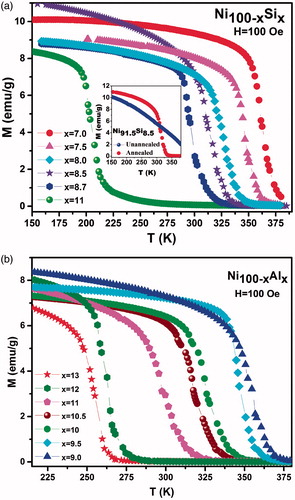
The TC values of the alloys were determined from the maximum of the differential magnetisation (dM/dT) of the M(T) curves with respect to temperature. Si and Al concentrations with respect to Curie temperature are shown in , where the Curie transition temperature decreases linearly with increasing Si and Al concentrations. The desired Curie temperature for hyperthermia treatment of cancer, 319 K (46 °C), was obtained for Ni91.5Si8.5 and Ni89.5Al10.5. Hence, we were able to obtain the desired magnetic ordering temperature between 300 K and 350 K (27 °C–77 °C) by adjusting Ni-Si and Ni-Al compositions.
The Curie temperature of the samples were also determined using another method, that is, from H/M vs. M2 plots (Arrott plots). shows the Arrott plots of Ni91.5Si8.5 and Ni89.5Al10.5 for H ≤ 50 kOe and 250 K ≤ T ≤ 380 K. By plotting H/M vs. M2 of the field-dependent magnetisation (H = 1/χ M + βM + γM+ · · ·), the intercept with the H/M-axis when extrapolated to M2 =0 gives 1/χ. The temperature at which 1/χ = 0 is the Curie temperature. TC calculated from Arrott plots for Ni91.5Si8.5 and Ni89.5Al10.5 were at temperatures range around 320 K (47 °C). The linear trend obtained from the Arrott plots was comparable to those obtained from the maximum of differential magnetisation (dM/dT) of the M(T) curves with respect to temperature.
Figure 4. The Arrott plots of Ni91.5Si8.5 and Ni89.5Al10.5 for a magnetic field change of 50 kOe in a temperature range of 250 to 380 K.
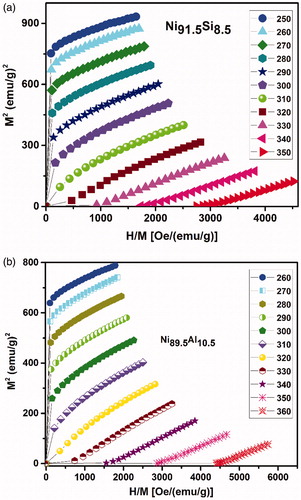
The magnetisation M(H) curves of Ni100-xSix and Ni100-xAlx at room temperature are shown in ), respectively. In all compounds, the magnetisation first rapidly increases, followed by slower increase with field, which is a typical ferromagnetic type of behaviour. The magnetisations of the samples decreased significantly with the addition of Si and Al concentrations. From the insets of ), one can see that the increase in the number of electrons per atom (e/A ratio) increases the saturation magnetic moment (Ms) for both Si and Al substitutions. The increase in Ms with Si and Al concentration could be attributed to a change in the 3D band structure due to a change in both the electron concentration and lattice parameters, or may related to the decrease in the Ni-Ni exchange interaction. From ), one can see that the samples are not purely ferromagnetic as the magnetisation did not reach the complete saturation.
Figure 5. Magnetisation as a function of a magnetic field for Ni100-xSix and Ni100-xAlx at room temperature. The inset shows the saturation magnetic moment as a function of conduction electron concentration at room temperature.
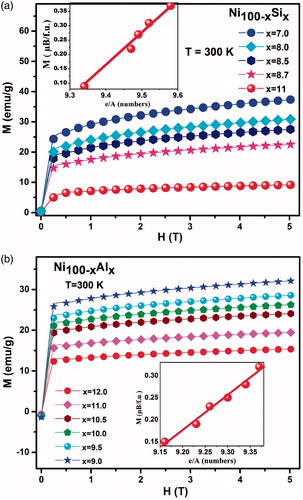
Another mechanism of heating utilise the magnetocaloric effect (MCE), which is different from the local magnetic hyperthermia effect, and was patented by Tishin [Citation23,Citation24]. The MCE occurs as a result of the alignment of magnetic moments with an external applied magnetic field. The alignment reduces the magnetic randomness, or the magnetic component of the total entropy. This reduction of magnetic entropy must be compensated by the increase in another form of entropy and, in the case of magnetocaloric (MC) materials, is channelled into phonons, or heat. Because the mechanism of heating in this case is different from the magnetic hyperthermia, it is named as magnetocaloric hyperthermia. For a thermodynamic Carnot cycle in a magnetocaloric material, the energy observed in one cycle is determined as [Citation25]:
(2)
where ΔSM is the magnetic entropy change.
The typical ΔSM curves for Si- and Al-doped Ni as the function of temperature are shown in . At the second-order transition (SOT), Ni91.5Si8.5 and Ni89.5Al10.5 exhibit a negative ΔSM of 1.6 J⋅kg−1⋅K−1 and 1.5 J⋅kg−1⋅K−1, respectively, in a magnetic field of 5 T. For the alloys Ni91.5Si8.5 and Ni89.5Al10.5, which have magnetic ordering temperature close to the human body temperature, the observed energy was 3.2 mJ/g and 2.9 mJ/g, respectively, in a field of 5 T. Using a frequency of 100 kHz, a specific absorption rate (SAR) of 300 W/g can be obtained for these alloys. These values are smaller than the value observed in Fe0.49Rh0.51 [Citation26]. In the case of a second-order transition, the magnetic entropy change (ΔSM) and the change in the alloy temperature (ΔT) depend on a 2/3 power function of the applied magnetic field [Citation27]. Thus, it will be possible to choose the proper magnetic field for human treatment using MCE materials. The refrigeration capacity, which are measures of the potential of materials to transfer heat in the vicinity of SOT, were found to be 168 J/kg and 142 J/kg for a magnetising field of 5 T for Ni91.5Si8.5 and Ni89.5Al10.5, respectively. These RC values are important when it is necessary to cool down the alloy after heating it to required temperature [Citation21].
Conclusion
Experimental studies of magnetic, magnetocaloric and structural properties have been carried out for Ni-Si and Ni-Al binary alloys. We have identified suitable composition of Ni-Si and Ni-Al materials which can be used as thermoseeds for self-controlled magnetic hyperthermia application. The desired Curie temperature for hyperthermia treatment of cancer, 319 K (46 °C), was obtained for Ni91.5Si8.5 and Ni89.5Al10.5 binary alloys with higher magnetisation than those reported for other Ni-based alloys. An alternative mechanism of heating by the use of the magnetocaloric effect has also been calculated and discussed. From these results, the Ni-Si and Ni-Al binary alloys may be a good candidate for self-regulating magnetic hyperthermia applications.
Acknowledgements
This work was supported by the Office of Basic Energy Sciences, Material Science Division of the U.S. Department of Energy, DOE Grant No. DE-FG02–06ER46291 (SIU) and DE-FG02–13ER46946 (LSU).
Disclosure statement
The authors report no declarations of interest.
Additional information
Funding
References
- Dewhirst MW, Gibbs FA Jr, Roemer RB, Samulski TV. (2000). Clinical radiation oncology. Chapter 14. 1st ed. New York (NY): Churchill Livingstone, 256–82.
- Falk MH, Issels RD. (2001). Hyperthermia in oncology. Int J Hyperthermia 17:1–18.
- Pankhurst QA, Connolly J, Jones SK, Dobson J. (2003). Applications of magnetic nanoparticles in biomedicine. J Phys D Appl Phys 36:R167–81.
- Bagaria HG, Johnson DT. (2005). Transient solution to the bioheat equation and optimization for magnetic fluid hyperthermia treatment. Int J Hyperthermia 21:57–75.
- Moroz P, Jones SK, Gray BN. (2002). Magnetically mediated hyperthermia: current status and future directions. Int J Hyperthermia 18:267–84.
- Kakehi M, Ueda K, Mukojima T, et al. (1990). Multi-institutional clinical studies on hyperthermia combined with radiotherapy or chemotherapy in advanced cancer of deep-seated organs. Int J Hyperthermia 6:719–40.
- Kampinga HH. (2006). Cell biological effects of hyperthermia alone or combined with radiation or drugs: a short introduction to newcomers in the field. Int J Hyperthermia 22:191–6.
- Wust P, Hildebrandt B, Sreenivasa G, et al. (2002). Hyperthermia in combined treatment of cancer. Lancet Oncol 3:487.
- Deger S, Taymoorian K, Boehmer D, et al. (2004). Thermoradiotherapy using interstitial self-regulating thermoseeds: an intermediate analysis of a phase II trial. Eur Urol 45:574.
- Mornet S, Vasseur S, Grasset F, Duguet E. (2004). Magnetic nanoparticle design for medical diagnosis and therapy. J Mat Chem 14:2161.
- Stauffer PR, Cetas TC, Fletcher AM, et al. (1984). Observations on the use of ferromagnetic implants for inducing hyperthermia. IEEE Trans Biomed Eng 31:76–90.
- Foster KR, Morrissey JJ. (2011). Thermal aspects of exposure to radiofrequency energy: report of a workshop. Int J Hyperthermia 27:307–19.
- Brezovich IA, Atkinson WJ. (1984). Temperature distributions in tumor models heated by self-regulating nickle-copper alloy thermoseeds. Med Phys 11:145.
- Johnnsen M, Geneveckow U, Eckelt L, et al. (2005). Clinical hyperthermia of prostate cancer using magnetic nanoparticles: presentation of a new interstitial technique. Int J Hyperthermia 21:637.
- Rehman J, Landman J, Tucker RD, et al. (2002). Ferromagnetic self-regulating reheatable thermal rod implants for in situ tissue ablation. J Endourol 16:523–31.
- Akin Y, Obaidat IM, Issa B, Haik Y. (2009). Ni1-xCrx alloy for self-controlled magnetic hyperthermia. Crystal Res Technol 44:386–90.
- Hergt R, Andra W, D’Ambly CG, et al. (1998). Physical limits of hyperthermia using magnetic fine particles. IEEE Trans Magn 34:3745–54.
- Shlyakhtin OA, Leontiev VG. Kuznetsov (2007). New manganite-based mediators for self-controlled magnetic heating. Smart Mater Struct 16:N35–9.
- Ahmad SN, Shaheen SA. (2007). Optimization of (Gd)5Si4 based materials: a step toward self-controlled hyperthermia applications. J Appl Phys 106:064701.
- Barati MR, Selomulya C, Sandeman KG, Suzuki K. (2014). Extraordinary induction heating effect near the first order Curie transition. Appl Phys Lett 105:162412.
- Pandey S, Quetz A, Aryal A, et al. (2017). Thermosensitive Ni-based magnetic particles for self-controlled hyperthermia applications. J Magn Magn Matt 427:200–5.
- Gautam BR. (2013). Study of dosimetric and thermal properties of a newly developed thermo-brachytherapy seed for treatment of solid tumors [PhD dissertation]. Ohio, USA: The University of Toledo.
- Tishin AM, Spichkin YI. (2003). The magnetocaloric effects and its applications. Bristol: Institute of Physics Publishing.
- Tishin AM. (2006). Method for carrying out a magnetic therapy of malignant neoplasm. WO 2006/135270 Al.
- Zatsepina E, Tishin AM Egolf PW, Vuamaz D. (2009). Magnetocaloric effect applied for a cancer tumor defeat: An improve hyperthermia method. Proceedings of the Third International Conference on the Magnetic Refrigeration at Room Temperature; 12--15 May 2009; Des Moines, USA. pp 487--96.
- Annaorazov MP, Asatryan KA, Myalikgulyev G, et al. (1992). Alloys of the Fe-Rh system as a new class of working material for magnetic refrigerators. Cryogenics 32:867–72.
- Oesterreicher H, Parkar FT. (1984). Magnetic cooling near Curie temperatures above 300 K. J Appl Phy 55:4334.

